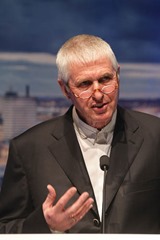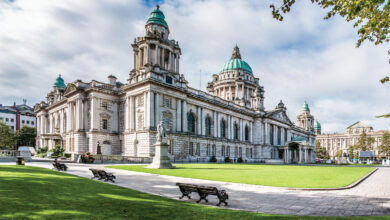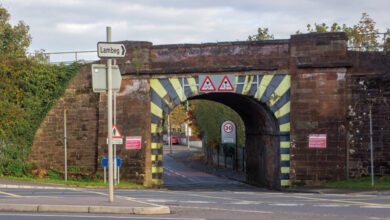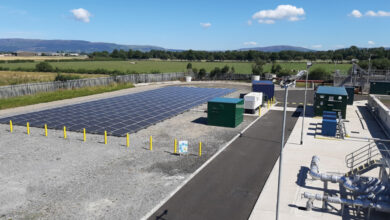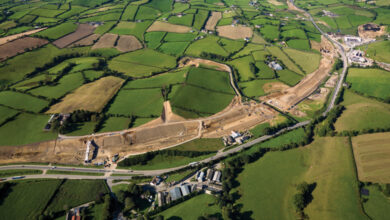Belfast: driving the regional economy
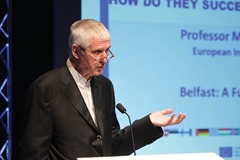 The city needs to develop a single, clear vision for its future and be properly recognised as an economic driver, according to Michael Parkinson. The cities expert discusses Belfast’s development with Owen McQuade.
The city needs to develop a single, clear vision for its future and be properly recognised as an economic driver, according to Michael Parkinson. The cities expert discusses Belfast’s development with Owen McQuade.
A critical friend of Belfast, Michael Parkinson, CBE is Director of the European Institute for Urban Affairs at Liverpool’s John Moores University. The city, in his view, has come a long way but needs strong leadership and a clear vision to make the most of its potential.
Parkinson has just completed a study for the European Commission looking at whether, in an age of austerity, governments should focus their investment on capital cities or whether they should spread the investment around their other cities.
“A lot of people have differing views on this but there was little evidence as to the best approach,” he recalls. “We looked at 31 countries and 155 cities and asked the question: ‘Do you have a better national economy if you have a number of high performing cities than if you just have a single dominant capital city?’ The answer is yes.”
The study found that decentralised decision-making and resource allocation, with less concentrated investment, leads to a better performing national economy. The countries with the best national spread of investment, such as Germany, performed best but those that concentrated investment in the capital (mainly in eastern Europe) have been less successful.
“So in an age of austerity, when governments tend to become risk-averse, you have to look outside the capital city,” Parkinson comments. “You have to produce investment-ready cities for when the recession ends.”
During the boom decade (1997-2007), the UK and other European countries “invested in a lot of second tier cities” and got a return on the investment. “I argue that there is a risk, well it’s now a reality, that the crunch will hit these places quicker and harder, and you risk the investment you made,” he adds. His argument is “as much about economic efficiency and investment as it is about fairness, social justice and territorial equity.”
Parkinson did a study ten years ago for Belfast City Council on ‘How competitive is Belfast?’ Back then, he found that the city “had come a decent way in a short time but it had got a lot further to go”. He came back in 2007 which, although we didn’t know it at the time, was the last year of the boom.
The city had experienced a “very good” decade with devolution, the peace dividend and a lot of investment: “I thought it was in really good order.” Retail, construction and financial services have since “taken a hit” in the recession but this has been no worse than in other places.
On his most recent visit, just before the Belfast: Future City conference, he asked key players in the city whether they were “more or less optimistic” than they were five years ago. The economic “crunch” and the fall-out from the flags dispute were causes for concern but he found “more cause for optimism than pessimism.”
Bringing more students into the city centre, through the University of Ulster’s move, is “a statement of confidence in the city and, in a way, an investment in the next generation.” A series of good events have sent out the right signals about the city: “Events really do matter.”
In itself, a feel-good factor will not bring employees into a city but it can keep them there.
“Clever, mobile, skilled people go to places for a job,” he continues. “If there isn’t a job, they don’t go and therefore, no matter how attractive the lifestyle is, they don’t go initially for that.” Lifestyle and place quality “determine who stays.”
Ten years ago, Belfast city centre “was not seen as the economic driver, or as safe territory or as a symbol of what the city could be” but now it is.
Belfast is, and will continue to be, in a very competitive global environment. Parkinson has just returned from South Korea which went through several decades of conflict but is now the twelfth largest economy in the world.
“They have put aside 60 to 70 years of ravaging conflict to achieve this,” he explains. “Clearly you cannot ignore Belfast’s past. History matters to this city. Culture and identity matter hugely. Cities want, and need to be, truthful to themselves and they need to be authentic but there is a point where you say ‘that is true but it is not the only truth’ and you have to look forward.”
He repeats the need for honesty when asked to outline some key drivers for success in the city.
“You need political leadership,” he adds. “A great deal more trust. These are very obvious things but that doesn’t make them less true. It seems to me that this is the time for big leadership, whether from the Assembly or Belfast City Council.”
With a population of 1.8 million, Northern Ireland is Belfast’s city region: the same size as Parkinson’s native Merseyside but smaller than greater Manchester.
“There has to be a recognition that all places matter and some places matter more than others,” he continues.
“Belfast really matters. If Belfast doesn’t drive the Northern Ireland economy, nothing else will. Belfast has got to play to its strengths and successes.”
This is not a matter of wanting other places to fail but they are “more likely to succeed if you have a successful Belfast.”
Crucially, more needs to be done to unite the city and create a clear vision for Belfast.
An important element of all successful cities is a “powerful and competent” local authority “which is elected and democratic and is also an economic driver.”
As reform approaches, Belfast City Council now has the opportunity to take on that role. As a result, Parkinson concludes, the council must receive the maximum capacity and resources “to drive the regional economy.”
Belfast as a place
Although much of Parkinson’s focus has been on economic issues, he emphasises the importance of seeing Belfast as a place. He asks the question: “What is Belfast for? What is its narrative?”
“We need to think about Belfast as a place and ask how the different bits fit together,”
he suggests. “Different communities live in different parts of the city. The relationship between the old city centre and the new Titanic Quarter needs to be thought through. What is the story for the future of Belfast and where should the investment go?”

